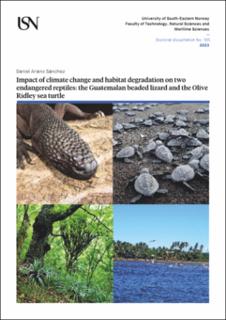Impact of climate change and habitat degradation on two endangered reptiles: the Guatemalan beaded lizard and the Olive Ridley sea turtle
Doctoral thesis
Published version
Permanent lenke
https://hdl.handle.net/11250/3069363Utgivelsesdato
2023-06-15Metadata
Vis full innførselSamlinger
- Ecology [25]
Sammendrag
Climate change and habitat degradation are the main threats to non-avian reptiles. Non-avian reptiles are a clade of ectothermic vertebrates that include turtles, alligators, lizards, amphisbaenians, and snakes. As ectotherms, their behavioural ecology is constrained by their thermal physiology which indeed is potentially affected by climate change and habitat degradation. This thesis examines how climate change and habitat degradation affect the ecology of endangered reptiles using two model species, one terrestrial (Guatemalan Beaded Lizard (Heloderma charlesbogerti)) and one marine species (Olive Ridley sea turtle (Lepidochelys olivacea)). First, I investigated the effects of seasonality and forest cover on the home range size, movement patterns, and habitat selection of the Guatemalan Beaded Lizard. Dry season home ranges and core areas were substantially smaller, and its associated lizard movement patterns showed shorter step lengths and smaller turning angles than those of the wet season. Larger lizards also had larger home ranges. When estimating dry forest selection within their home ranges, lizards with larger annual home range size and more forest cover within their home range showed higher selection for dry forest habitat. Second, I investigated how the strongest global interannual pattern of climate seasonality, El Niño Southern Oscillation (ENSO), can disrupt the annual phenological cycle of the Olive Ridley sea turtle in northern Central America. As proxies for nesting abundance, I analysed a 16-year period of Olive Ridley sea turtle nesting data. I found a clear overall upward trend in Olive Ridley sea turtle nesting abundance but no clear effect of ENSO variability on the numbers of nesting tracks and eggs buried in hatcheries. However, a decrease in the net change of eggs buried in hatcheries occurred in the respective years after the two extreme ENSO events during the study period. In the second year after those events, nesting abundance bounced back to resume the overall ascending trend. Third, this thesis examines how climate change can affect movement- related thermoregulation and activity intensity of the Guatemalan Beaded Lizard using GPS tags and triaxial accelerometry. I found a clear positive effect of ambient temperature on activity intensity and step-length of lizard movements. The movement also became more directional with increasing ambient temperatures. I propose that these patterns are indicative of internal state changes in the animals, as they move from a state of hunger, eliciting foraging, which is enhanced by lower temperatures and rainfall to a thermally stressed state, which initiates shelter-seeking. My findings highlight the sensitivity of this species to temperature change and indicate that predicted regional increases in temperature and reduction in rainfall are likely to negatively impact this species by reducing the width of their operational thermal window. Fourth, I also studied how vegetation loss and urbanization may affect the thermal profile of two Olive Ridley sea turtle nesting beaches with dark volcanic sand in northern Central America, and how sea turtle breeding ecology could be affected. Average sand temperatures at nesting beaches were almost always above the pivotal temperature, and either close to or above the thermal maximum tolerance of sea turtle embryos over longer periods. I found that higher air temperatures led to higher sand temperatures, and high relative humidity and precipitation led to lower sand temperatures. As expected, sand temperatures in plots covered by vegetation were lower than those without vegetation cover. Plots close to concrete structures showed the highest sand temperatures. My results highlight the relevance of vegetation and undisturbed nesting beaches in buffering the effects of high air temperatures, low relative humidity, and low precipitation rates at the study site, which will have profound implications for the resilience of Olive Ridleys to climate change. At last, I discuss perspectives on future research lines that can help improve our understating of the impacts of climate change and habitat degradation on non-avian reptiles. The combined results in this thesis may inform better conservation strategies for the two studied endangered model species.
Består av
Article 1: Ariano-Sánchez, D., Mortensen, R., Reinhardt, S., & Rosell, F.: Escaping drought: Seasonality effects on home range, movement patterns and habitat selection of the Guatemalan Beaded Lizard. Global Ecology and Conservation, 23, (2020), e01178. https://doi.org/10.1016/j.gecco.2020.e01178Article 2: Ariano-Sánchez, D., Muccio, C., Rosell, F. & Reinhardt, S.: Are trends in Olive Ridley sea turtle (Lepidochelys olivacea) nesting abundance affected by El Niño Southern Oscillation (ENSO) variability? Sixteen years of monitoring on the Pacific coast of northern Central America. Global Ecology and Conservation, 24, (2020), e01339. https://doi.org/10.1016/j.gecco.2020.e01339
Article 3: Ariano-Sánchez, D., Mortensen, R., Wilson, R., Bjüreke, P., Reinhardt, S., & Rosell, F. (2022). Temperature and Barometric Pressure Affect the Activity Intensity and Movement of an Endangered Thermoconforming Lizard. Ecosphere, 13(3), e3990. https://doi.org/10.1002/ecs2.3990
Article 4: Ariano-Sánchez, D., Nesthus, A., Rosell, F. & Reinhardt, S.: Developed black beaches - too hot to emerge? Factors affecting sand temperatures at nesting grounds of Olive Ridley sea turtles (Lepidochelys olivacea). Manuscript version submitted to Climate Change Ecology. The published version is available at https://doi.org/10.1016/j.ecochg.2023.100074

